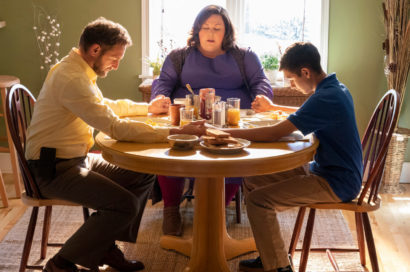Why Religious Movies Like ‘Breakthrough’ Are Attracting Non-Believers
by Heather Robinson

From The New York Post

In the movie “Breakthrough,” a Midwestern Christian mother, played with uncanny realism by Chrissy Metz of NBC’s prime-time hit “This is Us,” relentlessly prods doctors to save her son, even after they’ve given up hope.
She mobilizes her St. Louis community to pray, putting her faith in God — and science. And when her son rises from the dead, even the doctors agree it’s a miracle.
The success of this film, which became the country’s No. 2 movie in the first two days of its Easter week release, represents a breakthrough indeed: of faith-based films moving from the niche to mainstream.
For starters, this Disney/20th Century Fox offering is a star vehicle, complete with hip co-producers NBA superstar Stephen Curry and bestselling relationship author DeVon Franklin.
Based on the true story of John Smith, a basketball-loving 14-year-old from St. Louis who fell through an iced-over lake in 2015 and returned to life after 45 minutes without a pulse, “Breakthrough” has so far earned $37 million at the domestic box office and $46 million worldwide — more than three times its $14 million budget. It continues to hold strong at No. 8 in the country in its fifth week of release, and even cynical critics have given it a 64% fresh rating on Rotten Tomatoes. As The New York Times declared, “You don’t have to believe in divine intervention to be moved by this story.”
Faith and film have met before. From epics like “The 10 Commandments” and “Ben-Hur” during Hollywood’s Golden Age to 1970s comedies “Heaven Can Wait” and “Oh, God!” (with George Burns as the deity), filmmakers have long mined the spiritual for material. And recent decades have seen an explosion of faith-based films made by Christians for fellow believers.
But what’s new is that movies like “Breakthrough,” 2017’s “The Shack” with Octavia Spencer, 2016’s “Miracles from Heaven” with Jennifer Garner, and 2014’s “Heaven is for Real” with Greg Kinnear are being marketed by major studios to a mass audience. And more are in the pipeline: “Overcomer” (from Sony Pictures’ Affirm Films), a sports drama about a coach who uses prayer to rally student athletes in an economically depressed town, is set for an August release.
Pastor Samuel Rodriguez, one of the co-producers of “Breakthrough,” says its appeal is obvious.
“The world is hungry for authenticity, truth and experience,” Rodriguez told me. “Hollywood has recognized there is . . . a faith community and has decided, why not produce content that transcends that community? Look on Facebook and Instagram — it’s beautiful to see people of all creeds coming together, even nonbelievers, to enjoy this film.”
Although church attendance is dropping in America (Gallup found the percentage of US adults who belong to a church, synagogue or mosque plunged from 70% in the 1990s to an all-time low of 50% in 2018), spirituality is on the rise. Twenty-seven percent of Americans describe themselves as spiritual but not religious — up 8 percentage points in five years and consistent across race, age, sex, education level and political party, according to a 2017 survey by Pew.
“Perhaps the movie theater has become a pop-culture type of church to some,” said Richard T. Craig, associate professor of communication at George Mason University.
During the Great Depression, Americans found relief from the grind of daily life in the glamour of Hollywood films. Today, as more Americans sit alone in coffee shops navigating “social” media (an activity that often feels anti-social), films like “Breakthrough” can provide what we lack: spiritual elevation and a sense of community.
“Our film is a pushback on perpetual discord, strife and politically exacerbated silos … that separate us,” producer Rodriguez said. “It says we are one, and when we love together, believe together, and work together, God will respond.”
The doubters might argue that Hollywood has simply found a way to capitalize on our need for togetherness in increasingly divided times. But surely any trend that provides a ray of hope, with a message of healing and cooperation, should be welcomed. If the success of “Breakthrough” is any indicator, many Americans in 2019 are yearning — and ready — for that kind of miracle.



